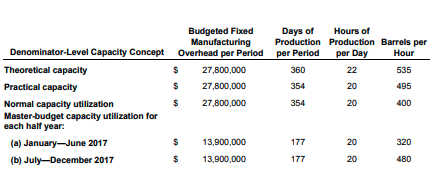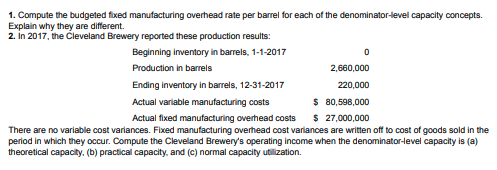Question
Here are the requirements Explain why they are different. The [ normal capacity utilization and master-budget utilization / normal capacity utilization and practical capacity /


Here are the requirements



Explain why they are different.
The [ normal capacity utilization and master-budget utilization / normal capacity utilization and practical capacity / theoretical and practical capacity / theoretical capacity and master-budget utilization ] concepts emphasize supply factors, while [ normal capacity utilization and master-budget utilization / normal capacity utilization and practical capacity / theoretical and practical capacity / theoretical capacity and master-budget utilization ] concepts emphasize demand factors.
The six-month rates for the master-budget utilization concept [ are different because of seasonal differences in budgeted production / are the same because of a standard budgeted production level.]





Honeygold Lager has just purchased the Cleveland Brewery. The brewery is two years old and uses absorption costing. It will "sell" its product to Honeygold Lager at $48 per barrel. Peter Bryant, Honeygold Lager's controller, obtains the following information about Cleveland Brewery's capacity and budgeted fixed manufacturing costs for 2017: (Click the icon to view the information.) Read the requirements. \begin{tabular}{lccccc} & & Budgeted Fixed Manufacturing & Days of Production Denominator-Level Capacity Concept & Hours of Production perhead per Period per Period & Ber Day Hour \\ \hline Theoretical capacity & $ & 27,800,000 & 360 & 22 & 535 \\ Practical capacity & $ & 27,800,000 & 354 & 20 & 495 \\ Normal capacity utilization Master-budget capacity utilization for & $ & 27,800,000 & 354 & 20 & 400 \\ each half year: & & & & & \\ (a) January-June 2017 & $ & 13,900,000 & 177 & 20 & 320 \\ (b) July-December 2017 & $ & 13,900,000 & 177 & 20 & 480 \end{tabular} 1. Compute the budgeted fxed manufacturing overhead rate per barrel for each of the denominator-level capacity concepts. Explain why they are different. 2. In 2017, the Cleveland Brewery reported these production results: There are no variable cost variances. Fixed manufacturing overhead cost variances are written off to cost of goods sold in the period in which they occur. Compute the Cleveland Brewery's operating income when the denominator-level capacity is (a) theoretical capacily, (b) practical capacity, and (c) normal capacity utilization. Requirement 1. Compute the budgeted fixed manufacturing overhead rate per barrel for each of the denominator-level capacity concepts Explain why they are different. Begin by determing the formula to calculate the budgeted fixed manufacturing overhead rate per barrel, then compute the rate for denominator-level capacity concepts. (Abbreviations used: Budg. = budgeted, MOH= manufacturing overhead. Round the rates to the ne: cent.) Theoretical capacity MOHed rate per barrel Theoretical capacity Practical capacity \begin{tabular}{ll} \hline & /4 \\ \hline & = \\ \hline \end{tabular} Normal capacity utilization I = Master-budget capacity for each half year: (a) January-June 2017 (b) July-December 2017 1= Requirement 2. Compute the Cleveland Brewery's operating income when the denominator-level capacity is (a) theoretical capacity, (b) practical capacity, and (c) normal capacity utilization. Begin by completing the following table to help you compute the operating income for each denominator-level capacity concept. (Round the rates to the nearest cent.) Now compute the operating income for each capacity concept, one at a time. Label the variances as favorable (F) or unfavorable (U). (Enter : "0" for any zero balance accounts.) Beginning inventory Variable manufacturing costs Fixed manufacturing overhead cost allocated Cost of goods available for sale Deduct ending inventory Adjustment for variances Cost of goods sold Cost of goods available for sale Deduct ending inventory Adjustment for variances Cost of goods sold Gross margin Other costs Operating income
Step by Step Solution
There are 3 Steps involved in it
Step: 1

Get Instant Access to Expert-Tailored Solutions
See step-by-step solutions with expert insights and AI powered tools for academic success
Step: 2

Step: 3

Ace Your Homework with AI
Get the answers you need in no time with our AI-driven, step-by-step assistance
Get Started


